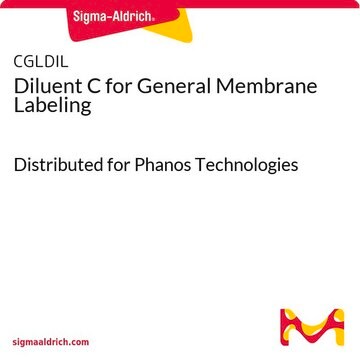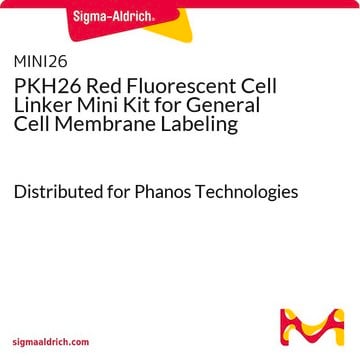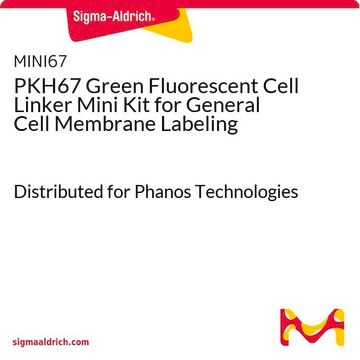BioTracker™ Membrane Dyes are lipophilic carbocyanine dyes. Lipophilic carbocyanine dyes have been used to stain neuronal cells in culture for several weeks, and in vivo for up to a year. The dyes do not appreciably affect cell viability and do not readily transfer between cells with intact membranes, allowing cell migration and tracking studies in mixed populations. The stability of labeling may vary between cell types, depending on rates of membrane turnover or cell division. Please see the link below to review the product datasheet:
https://www.sigmaaldrich.com/deepweb/assets/sigmaaldrich/product/documents/258/959/sct109ds.pdf
SCT109
BioTracker 400 Blue Cytoplasmic Membrane Dye
Live cell imaging lipophilic carbocyanine membrane dye suitable for long-term fluorescent cell labeling and cell tracking studies.
Synonym(s):
Live cell imaging probe, Live cell membrane dye
About This Item
Recommended Products
technique(s)
cell based assay: suitable
detection method
fluorometric
General description
Unlike PKH dyes, BioTracker Cytoplasmic Membrane Dyes do not require a complicated hypoosmotic labeling protocol. They are ready-to-use dye delivery solutions that can be added directly to normal culture media to label suspended or adherent cells in culture.
Spectral Properties
Absorbance: 366nm
Emission: 441nm
Application
Cell Imaging
Live Cell Dye
Components
2. 1 vial of 250µL Loading Buffer (CS224587)
Quality
Absorbance: 366nm
Emission: 441nm
Physical form
Storage and Stability
Note: Centrifuge vial briefly to collect contents at bottom of vial before opening.
Disclaimer
Storage Class Code
12 - Non Combustible Liquids
Flash Point(F)
Not applicable
Flash Point(C)
Not applicable
Certificates of Analysis (COA)
Search for Certificates of Analysis (COA) by entering the products Lot/Batch Number. Lot and Batch Numbers can be found on a product’s label following the words ‘Lot’ or ‘Batch’.
Already Own This Product?
Find documentation for the products that you have recently purchased in the Document Library.
-
After the staining, I am planing to culture the cells about a week and do imaging. For how many days would the cells be stained? After the cell division, would the flouresence be approximately halved and would both cells be florescent?
1 answer-
Helpful?
-
-
Hi, How necessary is placing the coverslip or chamber slide in a humidity chamber? I tried staining adherent cells in a glass bottom dish following the steps excluding the humidity chamber and was unable to get clear results.
1 answer-
Placing the coverslip or chamber slide in a humidity chamber is necessary to help maintain a moist environment during the staining process. It helps to prevent the drying out of the cells and the staining medium, allowing for better diffusion and interaction between the labeling solution and the cells.
Helpful?
-
-
Does it stain bacterial membrane?
1 answer-
This product is a lipophilic carbocyanine dye intended for use in plasma membranes and cells. The uptake is dependent on the lipid bilayer. It is not tested for the suitability of bacterial membrane, however given the make up of the bacterial cell wall it is unlikely.
Helpful?
-
-
Is this dye compatible to image live migrating HL60 cells?
1 answer-
This product is suitable for live cell imaging. The HL60 cell line has not been specifically tested, however there is no reason to expect it will not work. While this stain is markely more photostable that DAPI and other similar dyes, the retention time has not been determined. The addition of verapimil is recommended to improve retention time. See the link below for the product data sheet. The protocol can be found on page 2.
https://www.sigmaaldrich.com/deepweb/assets/sigmaaldrich/product/documents/258/959/sct109ds.pdfHelpful?
-
Active Filters
Our team of scientists has experience in all areas of research including Life Science, Material Science, Chemical Synthesis, Chromatography, Analytical and many others.
Contact Technical Service








